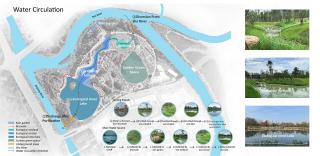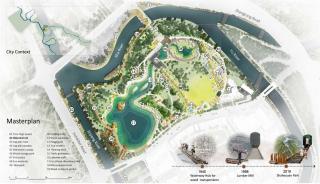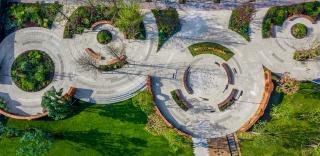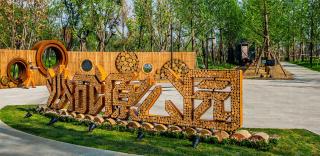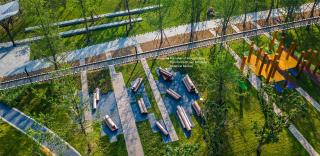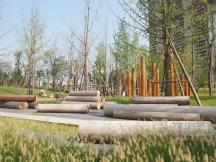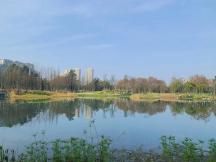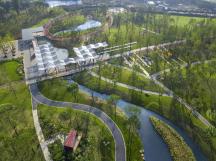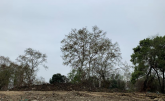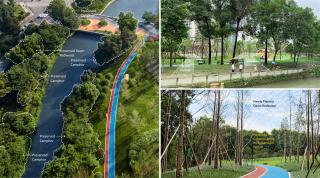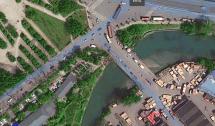沙河源公園前身是大西南建材城,歷史上作為成都的水運(yùn)樞紐。場(chǎng)地內(nèi)遺留的木材加工業(yè)的記憶,構(gòu)成獨(dú)具特色的場(chǎng)地特征。設(shè)計(jì)基于城市可持續(xù)性的視角,思考新時(shí)代下工業(yè)遺產(chǎn)的景觀更新與功能轉(zhuǎn)型,以此提出大西南建材廠的景觀再生策略。在充分保護(hù)場(chǎng)地內(nèi)遺留的工業(yè)遺產(chǎn)和歷史風(fēng)貌的基礎(chǔ)上,采用低干擾措施優(yōu)化原始生態(tài)環(huán)境,并融入適應(yīng)現(xiàn)代生活方式的城市功能。沙河源公園項(xiàng)目解決了工業(yè)遺產(chǎn)保護(hù)與城市轉(zhuǎn)型發(fā)展的矛盾,將城市中問題聚集的失落空間轉(zhuǎn)變?yōu)榫哂歇?dú)特場(chǎng)所精神的綠色空間,從而成為該行業(yè)的可持續(xù)發(fā)展的典例之一。

▲ 天府華年入口標(biāo)識(shí) ?LSSP

▲ 總平面圖 ? AECOM
沙河源公園所在地歷史上是成都水運(yùn)木材的重要樞紐,城市發(fā)展建設(shè)帶來了水運(yùn)的繁忙,成千上萬的漂木晝夜不息地流動(dòng)運(yùn)輸,促成成都木業(yè)空前繁榮。于1953年建設(shè)貯木場(chǎng),1998年正式更名為大西南建材城。但隨經(jīng)濟(jì)的發(fā)展,市場(chǎng)本身出現(xiàn)與城市發(fā)展不協(xié)調(diào)的地方,空間結(jié)構(gòu)與社會(huì)環(huán)境的矛盾,歷史遺存與發(fā)展更新的對(duì)抗,使得場(chǎng)地成為城市中的失落空間。2012年成都啟動(dòng)北城改造工程,將大西南建材城由此搬離市區(qū),原址成為集居住,商業(yè),公園的城市綜合體項(xiàng)目。
Shaheyuan Park has historically been an important waterway hub for wood transportation in Chengdu. In the 1950s, the urban construction of Chengdu brought with it increased waterway transportation activity. Thousands of logs were transported by waterway day and night, which further promoted the unprecedented prosperity of Chengdu Wood Industry. In 1953, the Chengdu Log Yard was formally established, and in 1998, was officially renamed the Southwest Lumber Mill. However, the log market itself appeared inconsistent with the development of the city and its economy. A conflict arose between the spatial structure and the social environment, and the dispute between historical relics and development updates began, making the site an abandoned part of the city. In 2012, the renovation project in the north part of Chengdu began, and the Southwest Lumber Mill was moved out of the city. The original site was planned for redevelopment as an urban complex integrating residential, commercial and park spaces.
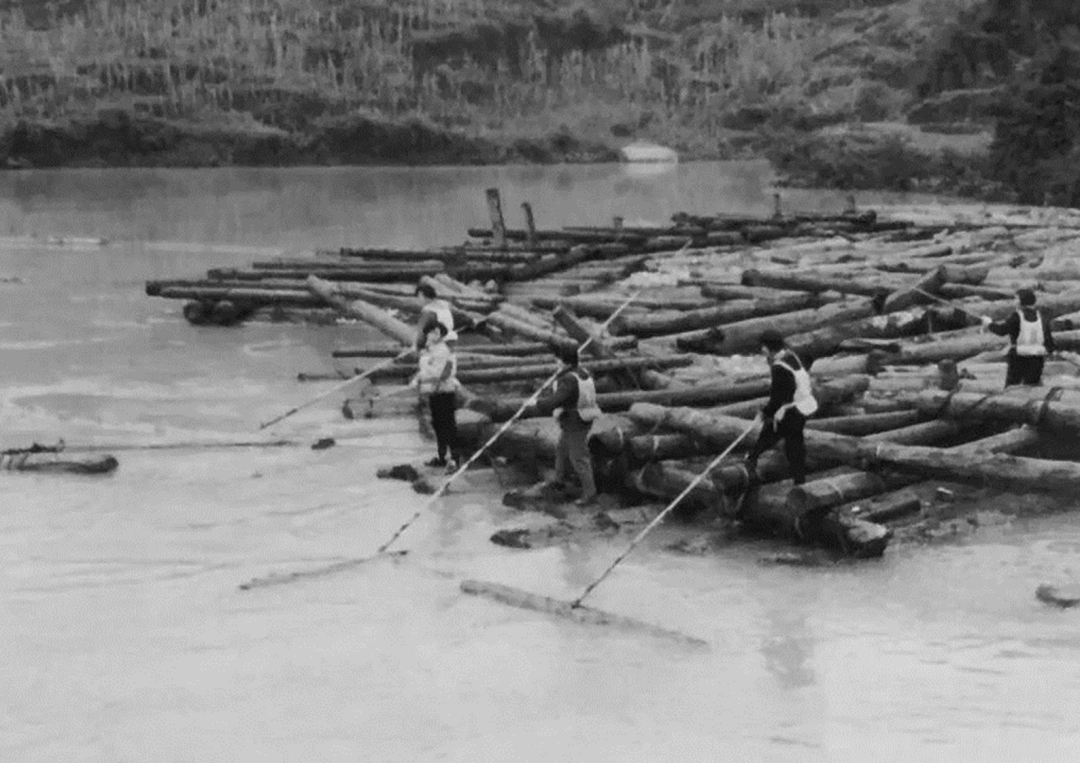
▲ 歷史上,成都水運(yùn)繁榮

▲ 大西南建材城場(chǎng)地現(xiàn)狀
2019年6月公園首先開放,為市民提供了全新的公共開放空間。在設(shè)計(jì)中,最大程度的尊重場(chǎng)地,保留原始生態(tài)環(huán)境,轉(zhuǎn)型融入現(xiàn)代生活方式。包括以原木為敘事原點(diǎn)的場(chǎng)所記憶轉(zhuǎn)譯系統(tǒng),自然生長的綠色生態(tài)系統(tǒng)以及多元開放的公眾參與活動(dòng)。同時(shí),場(chǎng)地位于錦江綠道規(guī)劃帶中,沙河源公園的建立,形成了連續(xù)的城市綠廊。
Shaheyuan Park first opened in June 2019, providing citizens with a new public open space. The project fully maximized and maintained the site's cultural memory and preserved the original ecological environment, while integrating urban functions that adapt to modern lifestyles. Specifically, the project integrated the site’s wood culture into the design, reshaping the relationship between human and nature and creating a people-oriented, multi-functional space. Additionally, as part of the Jinjiang Greenway planning belt, the establishment of Shaheyuan Park is aligned with the development of continuous urban green infrastructure in Chengdu.

▲ 鳥瞰圖 ? LSSP
設(shè)計(jì)目標(biāo)
Design Goals
基于城市可持續(xù)性的視角,將場(chǎng)地記憶與生態(tài)環(huán)境相融合,通過適應(yīng)現(xiàn)代城市生活方式的轉(zhuǎn)型,延續(xù)大西南建材城的歷史文脈,將城市中問題聚集的失落空間轉(zhuǎn)變?yōu)榫哂歇?dú)特場(chǎng)所精神的活力綠色空間。
Based on the perspective of urban sustainability, the park’s design merged the site’s legacy, ecological and environmental management and integrated urban functions for modern lifestyles. The Shaheyuan Park project has retained the cultural memory of the Southwest Lumber Mill and successfully transformed the abandoned area into a unique, green space.
設(shè)計(jì)概念
Design Concept
設(shè)計(jì)團(tuán)隊(duì)充分挖掘了木材廠的歷史記憶演變歷程,提煉場(chǎng)地元素,提出“林-木-人”的設(shè)計(jì)概念,重塑場(chǎng)所中土地、記憶與人的相互聯(lián)結(jié),重新煥發(fā)場(chǎng)地精神。
After fully researching the historical evolution of the lumber mill, the design team advocated a concept called “forest-wood-human.” In addition to reshaping the connection between the site’s memory and human interaction, the park’s design rebuilt an energetic space with unique cultural references to the site's heritage.

▲ 公園設(shè)計(jì)概念 ? AECOM
設(shè)計(jì)干預(yù)
Design Interventions
1. 融合演繹場(chǎng)地的歷史與文化
見證場(chǎng)地發(fā)展演變的重要因素:木,是代表這片土地情懷的場(chǎng)地記憶。以原木為敘事原點(diǎn),對(duì)場(chǎng)所的歷史與記憶進(jìn)行轉(zhuǎn)譯。通過“木材料-木運(yùn)輸-木加工-木儲(chǔ)存”的木材演替輪回,建構(gòu)“ 林-木-人“的關(guān)系,回溯從歷史上的水運(yùn)樞紐到木材廠到公園的轉(zhuǎn)變歷程。 設(shè)計(jì)最大化保留場(chǎng)地曾用來運(yùn)輸木材的遺留鐵軌,將其轉(zhuǎn)化為連接場(chǎng)地木材文化景觀節(jié)點(diǎn)的歷史記憶軸線, 同時(shí)也作為木材運(yùn)輸環(huán)節(jié)的展示節(jié)點(diǎn)。木樁迷宮和堆木樂園,儲(chǔ)木池依次展現(xiàn)了木材使用和儲(chǔ)存的環(huán)節(jié),重建了與場(chǎng)地歷史之間的聯(lián)系,并融入市民活動(dòng)空間。仿木廊架將木材文化以另一種形式儲(chǔ)存在場(chǎng)地中, 仿佛車站的月臺(tái)般, 成為了連接沙河源公園過去與未來中轉(zhuǎn)的站點(diǎn)。在人與景觀的互動(dòng)中喚起歷史上關(guān)于這片土地的集體記憶,塑造沙河源公園的場(chǎng)所精神。
1. Integrating the site’s history and culture into the design
Wood was chosen as the main element of Shaheyuan Park’s design. Having witnessed the development and evolution of the site, wood represents the feelings and memories connected with the land. It is used in the narrative to translate the history and memory of the site. The evolution of the site, from being a historical water transportation hub to a lumber mill, was depicted through the wood succession transformation cycle called ”forest-lumber-transportation-processing-storage.” The relationship of "forest-wood-human" has also been infused into the park.
The design maximized the remaining railway that used to transport wood, connecting wood culture nodes and serving as a remembrance of the area’s transportation heritage. The park features a log-pile maze, log-pile entertainment park, river corridors for wood-storage and educational exhibits which provide natural play opportunities for park visitors. The wood framework preserves the site’s wood culture in another form, becoming a gathering space for neighboring residents, and serving as a connecting link between the past and future of Shaheyuan Park.
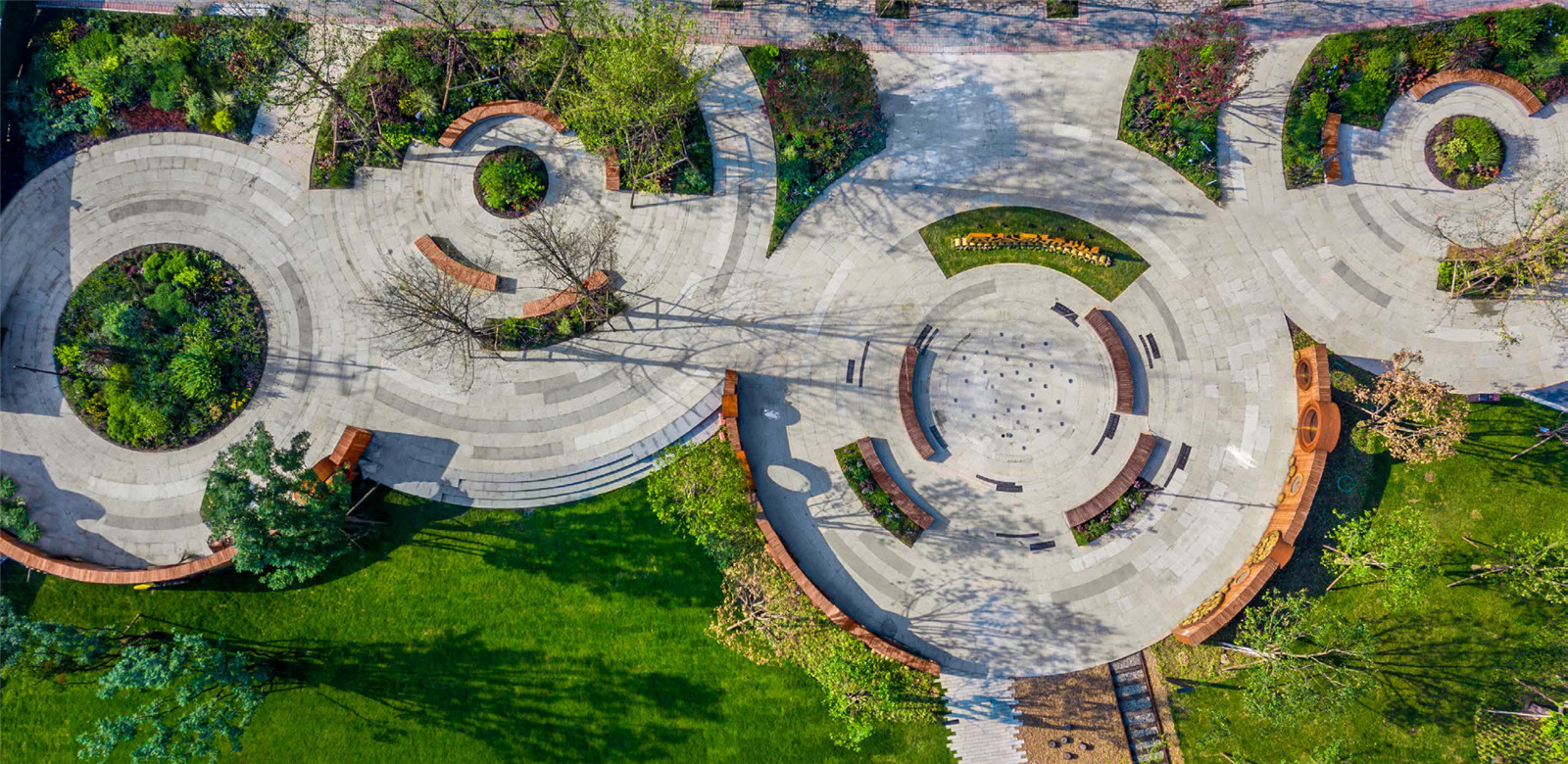
▲ 位于公園南部入口出的年輪廣場(chǎng) ?LSSP

▲ 保留了歷史鐵軌線 ?LSSP
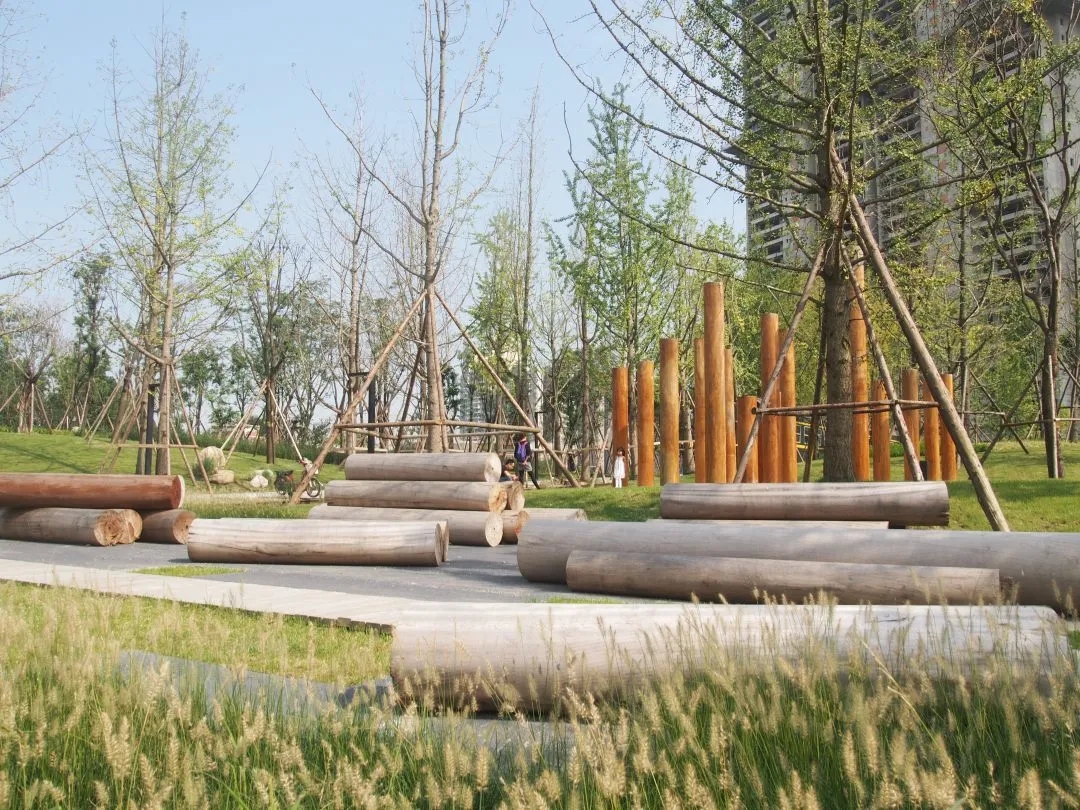
▲ 木樁迷宮 ?于海
2. 重塑人與自然的關(guān)系
公園是城市綠廊的重要節(jié)點(diǎn),基于可持續(xù)發(fā)展視角,運(yùn)用系列低干擾措施優(yōu)化原始生態(tài)環(huán)境。以保留河道周邊的現(xiàn)狀大樹為基礎(chǔ),并從生態(tài)系統(tǒng),季相變化,空間視線,植物色彩,四個(gè)方面,完善濱河植物組團(tuán)的群落結(jié)構(gòu),營造多樣的動(dòng)植物生境。 在水環(huán)境維持與提升策略方面:首先,公園引入沙河來聯(lián)通城市水系,允許河水進(jìn)入場(chǎng)地,并且在公園地勢(shì)最低處建立生態(tài)湖泊,在暴雨或洪水時(shí)可調(diào)節(jié)水位,來恢復(fù)場(chǎng)地原本的滯洪功能。其次,雨水徑流經(jīng)過生態(tài)草溝,雨水花園,濕地、生態(tài)溪流、滯留草坪等一系列海綿設(shè)施補(bǔ)給生態(tài)湖,同時(shí)也確保回到河流的溢流水得到凈化和過濾。湖底水下森林的設(shè)計(jì)為水生物多樣性提供了條件,兼具景觀與生態(tài)價(jià)值。
2. Reshaping the relationship between people and nature
Shaheyuan Park serves as an important node of the urban green corridor. The park’s design uses low-impact and low-intervention measures to optimize the original ecological environment. To preserve the existing mature trees along the riverbank, the riverside plant community was rehabilitated. This was done for the migratory corridor enhancement of native flora and fauna in line with the following four aspects: ecosystems, seasonal changes, spatial perspective and plant color.
In the aspect of water circulation: firstly, water from the Sha River was diverted to connect to the urban water system. Allowing water to enter and be retained in the site ― particularly during floods ― alleviates pressure on rivers and also reinstates the site's previous floodplain function. Secondly, rainwater runoff goes through a bioswale, rain garden, ecological wetland and ecological stream to replenish the ecological lake, also ensuring that overflow water returning to the river is filtered and of higher quality. Additionally, the design of the underwater forest at the bottom of the lake provides the conditions for aquatic biodiversity and has both landscaping and ecological value.

▲ 保護(hù)并優(yōu)化植物群落結(jié)構(gòu) ?LSSP

▲ 水循環(huán) ?AECOM
3. 打造以人文為本的,多功能復(fù)合的空間
過去車行為導(dǎo)向的城市開發(fā),使得北部市政橋主要服務(wù)于貨車通行,但隨著場(chǎng)地功能轉(zhuǎn)型,為營造步行友好、安全舒適的高品質(zhì)城市空間,將橋轉(zhuǎn)化為自行車道和人行友好的步道,完善城市慢性體系。通過增加綠色空間來縮小尺度,軟化場(chǎng)地的硬質(zhì)感,同時(shí)引導(dǎo)人車分流,增添景觀基礎(chǔ)設(shè)施,提供多元休閑的活動(dòng)空間。除此之外,在場(chǎng)地的轉(zhuǎn)型歷程中,周邊居住區(qū)存在人群多元化與差異化的發(fā)展趨勢(shì),不同社群體聚集于此,為滿足不同人群訴求,促進(jìn)社會(huì)公平,公園提供了多功能復(fù)合的活動(dòng)空間。
3. Creating people-oriented and multi-functional space
In the past, vehicle-oriented urban development led to the northern municipal bridge mainly serving truck traffic. However, due to the transformation of the site function, the renovated bridge replaced the unnecessary vehicle lanes with bikeways and a pedestrian-friendly platform, adding green spaces and seats, while guiding pedestrians and cyclists into the park — creating a safe and comfortable repurposed gateway bridge.In addition, during the functional transformation of the site, there is a trend that diversified and differentiated populations would gradually gather in the surrounding residential areas. Therefore, to satisfy the requirements from different groups of people, provisions are made for families, toddlers, children, elderly and adults throughout the park.
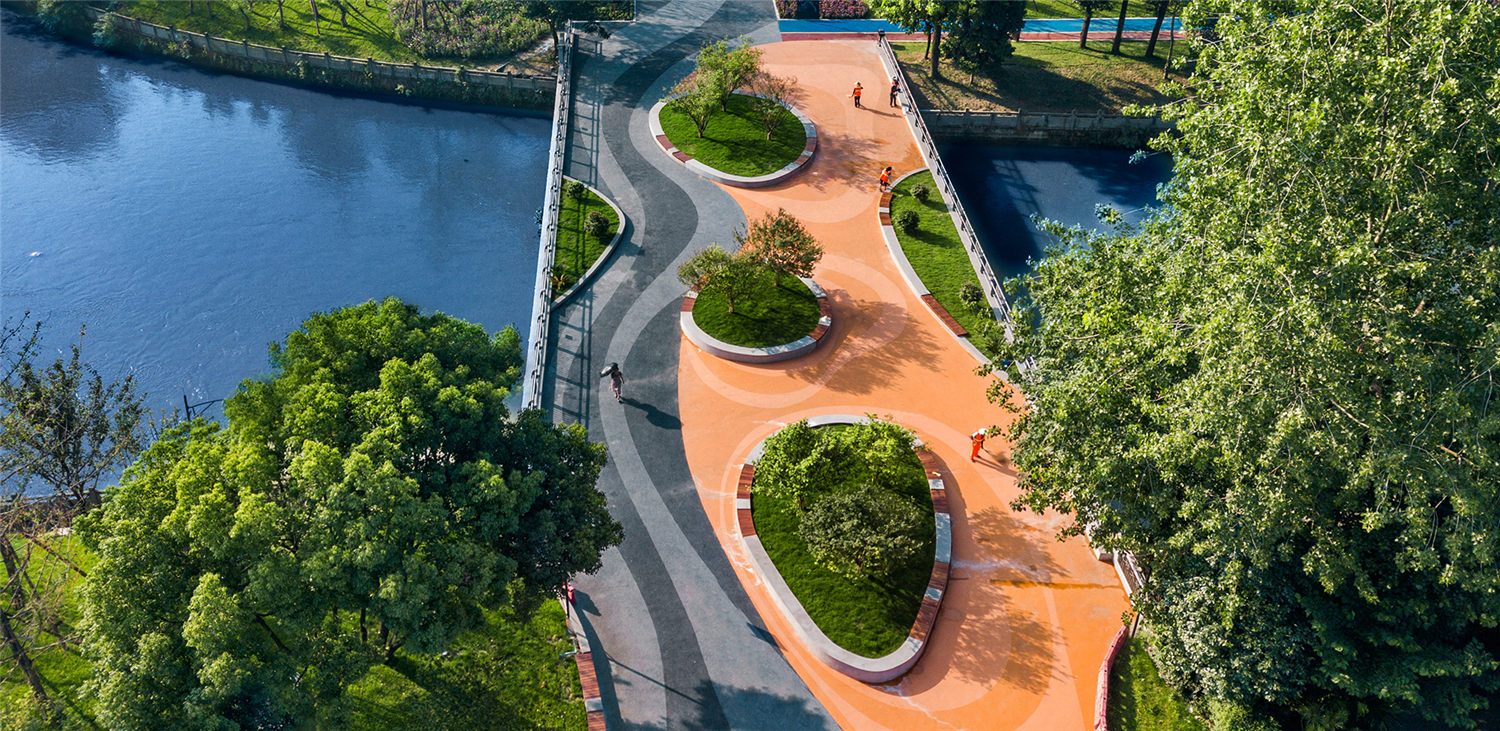
▲ 改造后的北部市政橋 ?LSSP

▲ 公園內(nèi)極具特色的大廊架 ?LSSP
沙河源公園以充滿特色的設(shè)計(jì)展露場(chǎng)地獨(dú)有個(gè)性,在古老的歷史上構(gòu)筑未來,以人為本,同時(shí)尊重木業(yè)遺緒的價(jià)值,與城市快速發(fā)展的步伐接軌,解決了工業(yè)遺產(chǎn)保護(hù)與城市轉(zhuǎn)型發(fā)展的矛盾。每一個(gè)細(xì)節(jié)都以獨(dú)具特色的場(chǎng)地歷史和可持續(xù)發(fā)展原則為基礎(chǔ),成功地將城市中問題聚集的失落空間轉(zhuǎn)變?yōu)榫哂歇?dú)特場(chǎng)所精神的活力綠色空間,從而成為該行業(yè)的可持續(xù)發(fā)展的典范案例之一。
Every detail of the Shaheyuan Park project is based on the unique site history and the principle of sustainable development. By expressing unique characteristics with a special design developed from its historical legacy, It celebrates the value of wood, embraces a people-oriented philosophy and is blended with the rapid development of the city.

項(xiàng)目名稱:成都沙河源公園
位置:四川成都
委托方:中國電建地產(chǎn)西南區(qū)域、成都市金牛城建投資有限公司、成都岷江海賦投資有限責(zé)任公司
合作方:成都澳博景觀設(shè)計(jì)有限公司
服務(wù)范圍:景觀設(shè)計(jì)
面積:11.7公頃
設(shè)計(jì)時(shí)間 :2015-2018
建成時(shí)間:2019年
榮獲獎(jiǎng)項(xiàng):
Citation Award, Urban Design, AIA Shanghai | Beijing Design Awards 2020
2020第四屆ELA國際景觀大獎(jiǎng) - ELA年度十大景觀項(xiàng)目、最具社會(huì)影響力銀獎(jiǎng)、最佳開放空間金獎(jiǎng)
主創(chuàng)及設(shè)計(jì)團(tuán)隊(duì):沈同生、 Lee Parks、 范垂勇、于海、劉曉丹、閆偉、楊嬌妮、蘇嫻、彭瑾韌、巫依琳、劉迪軒、鄭亞君
Client:PowerChina Real Estate Group Ltd. Southwest, Chengdu Golden Bull District Construction Investment Co., Ltd., Chengdu Minjiang Haifu Investment Co., Ltd.
Partner:AOBO Landscape
Site Area:11.7 hectares
Service Provided:Landscape
Design Year :2015-2018
Completion Year:2019
Awards:Citation Award, Urban Design, AIA Shanghai | Beijing Design Awards 2020
Best Open Space Landscape Design Project (Gold Award) & Annual Best Ten Landscape Design Project & Most Socially Impactful Landscape Design Project (Silver Award), 2020 ELA Awards
Lead Designer and Project Team:Stone Shen, Lee Parks, Chuiyong Fan, Hai Yu, Xiaodan Liu, Wei Yan, Jiaoni Yang, Xian Su, Jinren Peng, Yilin Wu, Dixuan Liu, Yajun Zhuang
版權(quán)聲明:本文由作者于景觀中國網(wǎng)發(fā)布,僅代表作者觀點(diǎn),不代表景觀中國網(wǎng)立場(chǎng)。如轉(zhuǎn)載、鏈接、轉(zhuǎn)貼或以其它方式使用本稿,需注明“文章來源:景觀中國網(wǎng)”。如有侵權(quán),請(qǐng)與發(fā)布者或我們聯(lián)系。
投稿郵箱:info@landscape.cn
 京公海網(wǎng)安備 110108000058號(hào)
京公海網(wǎng)安備 110108000058號(hào)














